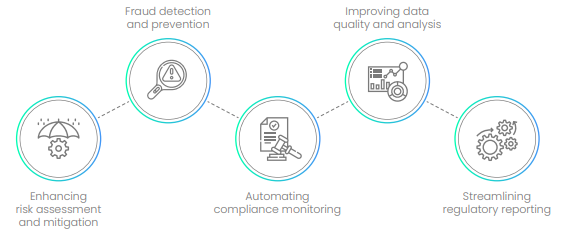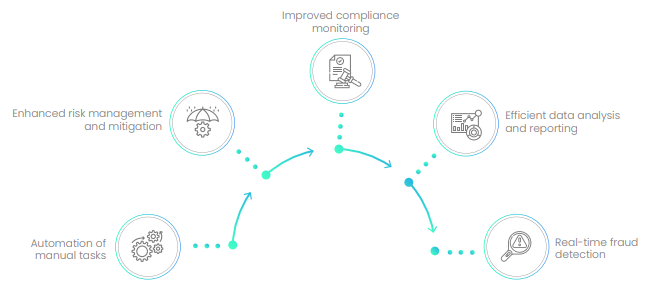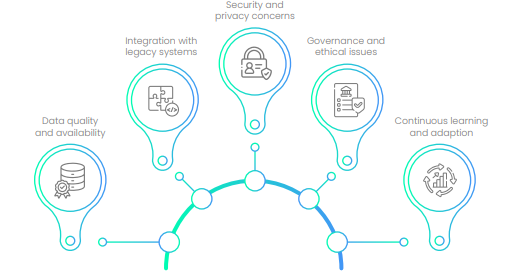In an era of rapid technological advancements, the integration of artificial intelligence (AI) into various industries has become inevitable. One area where AI is making a significant impact is Governance, Risk, and Compliance (GRC). The convergence of AI and GRC is revolutionizing the way organizations approach governance, manage risk, and ensure compliance.
Unlocking the Power of AI & ML in GRC
In the realm of GRC, the integration of Artificial Intelligence (AI) and Machine Learning (ML) is causing a paradigm shift in how organizations handle risk, bolster compliance efforts, and make well-informed decisions. The following are ways in which AI and ML can elevate your GRC processes:
- Advanced Risk Assessment: AI and ML techniques enable organizations to analyze large amounts of data, uncover patterns, and identify potential risks. Automated risk assessment processes evaluate the likelihood and impact of risks, facilitating proactive risk management and mitigation.
- Simplified Compliance Monitoring: AI simplifies regulatory compliance monitoring by swiftly analyzing extensive datasets against relevant regulations and policies. It detects anomalies and potential breaches, generating timely alerts for investigation. This ensures ongoing compliance while reducing manual effort.
- Combatting Fraud: AI and ML can detect and prevent fraud within GRC initiatives. By analyzing historical transaction data, user behavior patterns, and other relevant information, these technologies identify suspicious activities. Prompt action can be taken to safeguard the organization’s integrity.
- Intelligent Predictive Insights: AI and ML enable organizations to leverage predictive analytics for informed decision-making in GRC strategies. By analyzing historical data, patterns, and trends, these technologies forecast potential risks and compliance issues. Proactive measures can then be taken to optimize governance processes.
- NLP for Enhanced Analysis: AI’s Natural Language Processing (NLP) capabilities extract critical information and deeper insights from unstructured textual data, such as legal and regulatory documents. This streamlines compliance analysis by efficiently classifying documents and identifying key clauses, saving time and effort.
- Intelligent Automation: AI and ML offer intelligent automation, freeing GRC professionals from repetitive tasks. Automating activities like compliance monitoring and risk assessment allows teams to focus on strategic initiatives, enhancing productivity and efficiency.
AI in GRC – Realtime
AI systems have the potential to make decisions and draw conclusions based on complex algorithms and data. However, errors or biases in these systems can lead to unintended consequences such as compliance violations, reputational damage, and financial losses. To mitigate these risks, organizations must establish tailored governance, risk management, and compliance frameworks for AI. Here are five critical questions for board directors and senior executives to consider:
Do we know which business units, departments, or functions are already using AI and how they utilize it?
Identifying all AI systems within the organization can be challenging, especially if some teams are using AI without the knowledge of the IT department. Conducting an audit in collaboration with IT is essential to gain a clear understanding of AI usage.
Have we documented governance processes for AI development, deployment, and use?
Developing comprehensive and flexible governance processes for AI involves various stakeholders, including data scientists, IT professionals, and business leaders. Engaging with these stakeholders to understand their needs and concerns is crucial in establishing effective governance.
Do we have a systematic approach to evaluate gaps, overlaps, and risks associated with AI use?
The complexity of AI systems, with multiple algorithms, data sources, and models, makes risk evaluation challenging. Collaborating with data scientists and AI experts is key to developing a rigorous methodology for identifying and evaluating risks related to AI usage.
How do we identify and manage reputational, relational, regulatory, and operational risks while remaining agile in adapting to AI changes?
AI technology is dynamic, requiring organizations to be agile in risk identification and management. Working with legal, compliance, and risk management professionals is necessary to assess and manage risks associated with AI, ensuring compliance, and adapting to the evolving AI landscape.
How can we ensure transparency, dependability, and credibility of our AI algorithms and models?
Building trust in AI systems involves developing algorithms and models that are explainable, reliable, and trustworthy. Collaboration with data scientists and AI experts is essential to ensure transparency and credibility of AI systems for stakeholders.
Using AI to enhance Employee Experience
Integrating AI into employee experience offers significant advantages. One example is the implementation of AI-powered search capabilities in policies and procedures, enabling intelligent searches. This empowers employees to ask questions and find information using their own terms, enhancing accessibility, and increasing the likelihood of finding relevant information. This positively impacts an organization’s compliance culture.
Additionally, administrators no longer need to include every possible keyword in policy documents. They can focus on crafting effective policies while relying on AI to deliver the appropriate content to users. AI-enabled search functions can be limited to information extracted from the company’s policies, ensuring data security and relevance.
This approach extends beyond policies to encompass a searchable code of conduct and compliance training for employees. The language modeling capabilities of AI can also identify indicators for potential incident reports, simplifying the reporting process for employees.
What is the role of AI and ML in GRC solutions?
AI & ML are transforming GRC software, improving risk assessment, compliance monitoring, and decision-making. Their role will continue to expand, shaping the future of intelligent and proactive governance, risk, and compliance solutions.

What are the benefits of employing AI & ML in GRC software?
Leveraging AI & ML in GRC software yields benefits like enhanced risk assessment, improved compliance monitoring, and advanced predictive analytics, empowering better decision-making and proactive risk management.

What are the challenges of implementing AI & ML in GRC software?
Implementing AI and ML in GRC systems presents challenges for organizations. Key hurdles include data quality, algorithm bias, interpretability, and ethical considerations, requiring careful planning and expertise for successful integration.

I am text block. Click edit button to change this text. Lorem ipsum dolor sit amet, consectetur adipiscing elit. Ut elit tellus, luctus nec ullamcorper mattis, pulvinar dapibus leo.
In the AI-driven era of GRC, organizations benefit from improved efficiency, risk assessment, and decision-making. However, challenges include potential biases, lack of transparency, and the need for effective governance to ensure ethical and responsible use of AI technologies.
Relevant Links for Further Exploration

Author
Praveenkumar
Praveen is a cybersecurity lead with 11 years of experience in the IT industry. His expertise encompasses IT infrastructure, Identity and Access Management (IAM), and the last five years have been dedicated to Governance, Risk, and Compliance (GRC). Additionally, Praveen is an active traveler and motorcycle enthusiast. He channels his passion for biking by running a biking club in the state.




